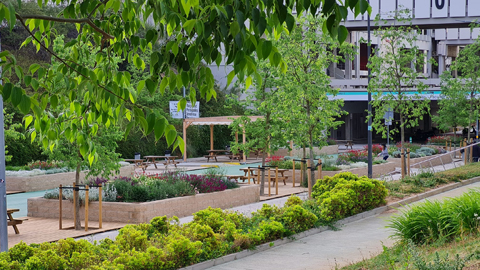The UAB committed to providing naturalised climate refuges
To deal with the extreme temperatures associated with climate change, the UAB aims to provide as many naturalised climate shelters as possible. To date 150 trees have been planted, 81 of which have helped to create two new climate refuges on campus. They were planted in areas previously covered in cement or waiting to be urbanised, thus creating more naturalised spaces that offer shade when the sun is strongest. The climate shelters were placed at the Plaça del Coneixement (where 45 lime trees were planted along a 135-metre long path) and at the Plaça de l’Enginyeria (in which a 1,300 m2 area previously occupied by a car park has now been filled with 36 horse chestnuts and vines).

In addition to make the temperature more comfortable, climate shelters are also a place for meeting and interacting with other who also form part of the university community.
The UAB Bellaterra campus is made up of some 260 hectares, where there are a total of 4,000 trees in the campus’ green areas alone (without counting all the trees existing in the forest areas of the campus), and more than 90 different species and subspecies, with a predominance of white pine trees, nettle trees, poll trees and stone pine trees. A total of 50,000 people can move around these areas each day.
In the past years, the UAB has gradually introduced a change in the management of the campus, with practices that are more respectful with the trees and their surroundings, and in favour of renaturalising the campus. More recently, due to the lockdown during the coronavirus pandemic, followed by a series of episodes of extreme weather conditions in Catalonia, there is a change in society’s opinion and habits in general, and in the university community in particular, has translated into a greater demand for outdoor spaces adapted to these new climate conditions. That is why the UAB is working hard to provide climate shelters.
The objective of a climate shelter is to provide thermal comfort under extreme weather conditions, protecting from the heat and even from cold. These shelters can be either outdoor spaces or conditioned indoor spaces, although in coherence with a reduction in its carbon footprint, the UAB will always strive to find nature-based solutions.
In the cased of outdoor areas, these refuges are created with the aim of minimising the effects of heat waves, using plants and trees and some areas in which water and shade is provided, and other low-energy and resource consumption alternative.
That is why the UAB is creating new spaces that will become climate shelters in areas in which only concrete existed. One of them is the climate refuge created at the Plaça del Coneixement, with 45 lime trees plants on a 135-metre long path along the square, and another is the climate refuge at the Plaça de l’Enginyeria, which transformed an area measuring 1,300 m2 until now used as a car park into a space containing 36 horse chestnut trees and vines. Several benches have also been added to the square.
In addition to improving the temperature on campus, these new areas are becoming a place for meeting and interacting with other members of the univeristy community, and at the same time can serve to conduct outdoor lectures and other academic activities.
In this sense, the Espai SiS is also an example of how to conquer a space previously dominated by cars thanks to the substantial change made to the campus’ Eix Central which is now clearly a new area where the univeristy community can congregate, merging it with the already existing green area found on both sides of the campus’ central creek bed.
Components of a climate shelter
Among the main functions of the trees are the shade they provide, the humidity they give to the air, their ability to store contaminating elements in the air and a reduction in noise. In addition, some trees produce food and are a source of raw material, as well as giving refuge to animals, being aesthetically important and favouring the emotional well-being of people.
In order to turn an area into a climate shelter, it is important to take into account its main function, whether that be a street needing shade for people to walk under, a square for people to meet, or an area in which to have fun, study or meet with friends, or simply to create a more welcoming urban landscape.
With regards to the species planted, in addition to the diversity what must be considered are aspects such as the adaptation to the area in which they are planted, the dimension of their treetops, the characteristics of their leaves, being able to extend their roots into the soil and whether they may cause allergies.
The origins of today’s climate refuges: garden parks as leisure areas
In addition to deliberately creating new areas as climate refuges, the UAB campus has planted many trees since its founding, particularly in the vecinity of buildings, to offer shade and protection from extreme weather conditions, the same which are now taking on a particular relevance. This is the case of the plane trees in the middle of the Plaça del Coneixement, the garden area between buildings B and C, the pine grove in front of the Faculty of Veterinary Medicine and holm oak trees close to the Rectorat building.
The UAB, with Sustainable Development Goals
Affordable and clean energy
Responsible consumption and production
Sustainable cities and communities
Clean water and sanitation
Climate action